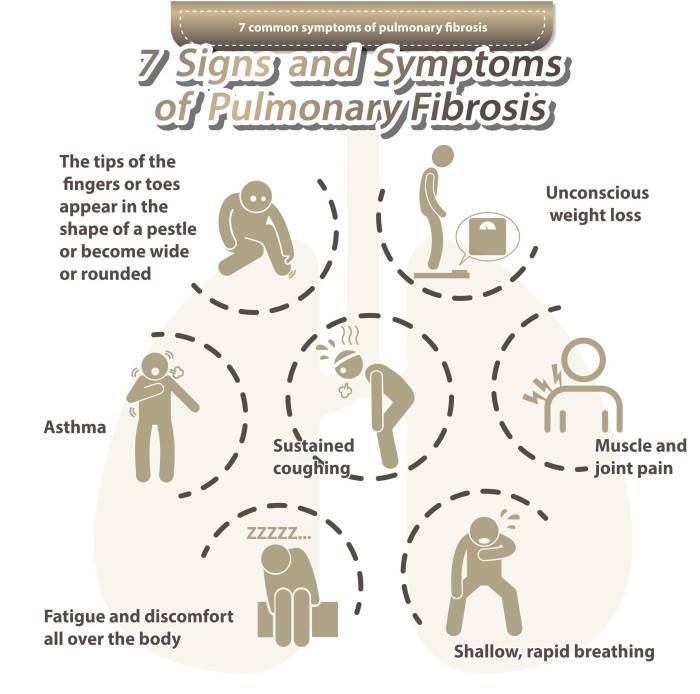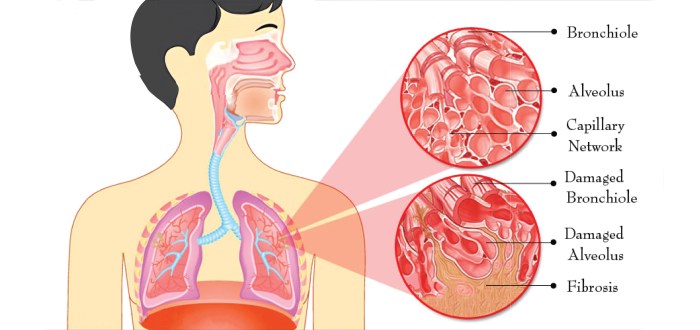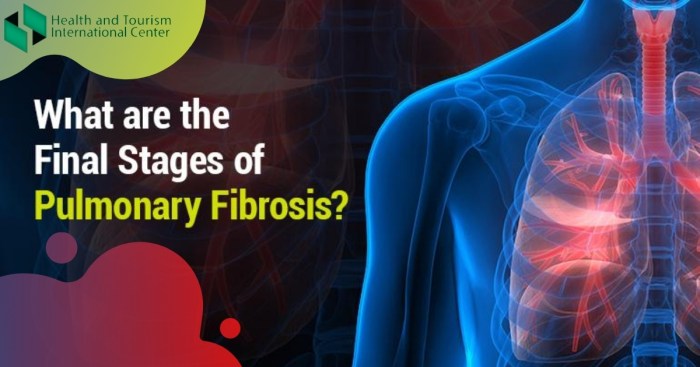Symptoms of lung fibrosis can vary depending on the severity of the condition, but they typically include shortness of breath, a dry cough, and fatigue. As the condition progresses, other symptoms may develop, such as wheezing, chest pain, and weight loss.
Early diagnosis and treatment are crucial for managing lung fibrosis and improving outcomes.
Introduction

Lung fibrosis is a chronic lung disease that causes scarring of the lung tissue. The scarring makes it difficult for the lungs to work properly, leading to shortness of breath, coughing, and fatigue.
There is no cure for lung fibrosis, but there are treatments that can help to slow the progression of the disease and improve the quality of life for people with the condition.
Causes
The exact cause of lung fibrosis is unknown, but it is thought to be caused by a combination of genetic and environmental factors.
- Genetic factors:Some people are more likely to develop lung fibrosis if they have a family history of the condition.
- Environmental factors:Exposure to certain toxins, such as asbestos, silica, and coal dust, can increase the risk of developing lung fibrosis.
Causes and Risk Factors
Lung fibrosis is a condition in which the lung tissue becomes scarred and thickened, making it difficult to breathe. The exact cause of lung fibrosis is often unknown, but there are a number of known risk factors.
One of the most common causes of lung fibrosis is exposure to certain toxins, such as asbestos, silica, and coal dust. These toxins can damage the lung tissue over time, leading to scarring and fibrosis. Other causes of lung fibrosis include autoimmune diseases, such as rheumatoid arthritis and lupus, and certain medications, such as chemotherapy drugs and radiation therapy.
Risk Factors
There are a number of risk factors that can increase the likelihood of developing lung fibrosis. These include:
- Exposure to certain toxins, such as asbestos, silica, and coal dust
- Having an autoimmune disease, such as rheumatoid arthritis or lupus
- Taking certain medications, such as chemotherapy drugs and radiation therapy
- Having a family history of lung fibrosis
- Smoking
- Being exposed to secondhand smoke
- Having certain lung conditions, such as chronic obstructive pulmonary disease (COPD) or idiopathic pulmonary fibrosis (IPF)
Symptoms
Lung fibrosis is a progressive lung disease that causes scarring of the lung tissue. This scarring makes it difficult for the lungs to function properly, which can lead to a variety of symptoms. The symptoms of lung fibrosis can vary depending on the severity of the disease, but some of the most common symptoms include:
Respiratory Symptoms
- Shortness of breath, especially with exertion
- Wheezing
- Cough
- Chest pain
- Fatigue
- Rapid heart rate
Systemic Symptoms
- Weight loss
- Loss of appetite
- Muscle weakness
- Joint pain
- Skin rashes
- Dry mouth
Diagnosis

Diagnosing lung fibrosis involves a comprehensive evaluation that includes a thorough medical history, physical examination, and a variety of tests and procedures. The goal is to confirm the presence of fibrosis, determine its extent and severity, and identify any underlying causes.
The diagnostic process typically begins with a detailed medical history, which includes questions about symptoms, risk factors, and past medical conditions. The doctor will also perform a physical examination, paying particular attention to the lungs and listening for any abnormal sounds, such as crackles or wheezing.
Imaging Tests
- Chest X-ray:A chest X-ray can reveal patterns of fibrosis in the lungs, such as scarring or interstitial thickening.
- High-resolution computed tomography (HRCT):HRCT is a specialized X-ray technique that provides detailed images of the lungs, allowing for a more precise assessment of fibrosis.
Lung Function Tests
Lung function tests measure the volume and flow of air in and out of the lungs. These tests can help determine the extent of lung damage caused by fibrosis and assess the severity of the condition.
Bronchoscopy
Bronchoscopy is a procedure that involves inserting a thin, flexible tube with a camera into the airways to visualize the inside of the lungs. During bronchoscopy, the doctor may collect samples of lung tissue (biopsy) for further examination under a microscope.
Blood Tests
Blood tests can help identify certain biomarkers that are associated with lung fibrosis, such as elevated levels of certain proteins or antibodies. These tests can also rule out other conditions that may mimic lung fibrosis.
Treatment
Lung fibrosis is a progressive disease, and there is currently no cure. However, there are a number of treatments available that can help to slow the progression of the disease and improve symptoms.The goals of treatment for lung fibrosis are to:
- Relieve symptoms
- Slow the progression of the disease
- Improve quality of life
The type of treatment that is recommended for a particular patient will depend on the severity of their disease and their overall health.
Medications
There are a number of medications that can be used to treat lung fibrosis. These medications include:
Anti-inflammatory drugs
These drugs can help to reduce inflammation in the lungs.
Immunosuppressants
These drugs can help to suppress the immune system, which can slow the progression of the disease.
Antifibrotic drugs
These drugs can help to prevent the formation of scar tissue in the lungs.
Oxygen therapy
Oxygen therapy can help to improve oxygen levels in the blood. This can help to relieve symptoms such as shortness of breath and fatigue.
Pulmonary rehabilitation
Pulmonary rehabilitation is a program of exercise and education that can help to improve lung function and quality of life.
Lung transplant
In some cases, a lung transplant may be necessary. This is a major surgery, but it can be life-saving for people with severe lung fibrosis.
Limitations of treatment
It is important to note that there are no guarantees with any of the treatments for lung fibrosis. The goal of treatment is to slow the progression of the disease and improve symptoms, but it is not always possible to completely stop the disease.In addition, some treatments can have side effects.
It is important to discuss the risks and benefits of treatment with your doctor before making a decision about which treatment is right for you.
Prognosis and Outlook
The prognosis for people with lung fibrosis can vary widely depending on the type and severity of the disease. In general, however, the outlook for people with lung fibrosis is not good. The disease is usually progressive, meaning that it worsens over time.
In some cases, lung fibrosis can lead to respiratory failure and death.
Factors That Can Influence the Prognosis
A number of factors can influence the prognosis for people with lung fibrosis, including:
- The type of lung fibrosis. Some types of lung fibrosis are more aggressive than others.
- The severity of the disease. The more severe the disease, the worse the prognosis.
- The age of the person. Older people with lung fibrosis tend to have a worse prognosis than younger people.
- The presence of other medical conditions. People with other medical conditions, such as heart disease or cancer, tend to have a worse prognosis than people without these conditions.
Related Conditions

Lung fibrosis can be associated with several other conditions, which may influence its diagnosis and treatment approach.
These related conditions can present similar symptoms to lung fibrosis, making it crucial to conduct thorough differential diagnoses to ensure accurate identification of the underlying cause.
Autoimmune Disorders
- Rheumatoid arthritis
- Scleroderma
- Sjögren’s syndrome
Autoimmune disorders can trigger inflammation and scarring in various organs, including the lungs, leading to lung fibrosis.
Occupational Exposures, Symptoms of lung fibrosis
- Asbestos exposure
- Silica exposure
- Coal dust exposure
Exposure to certain hazardous substances in occupational settings can cause lung damage and inflammation, potentially resulting in lung fibrosis.
Connective Tissue Diseases
- Systemic lupus erythematosus
- Polymyositis
- Dermatomyositis
Connective tissue diseases involve inflammation and damage to connective tissues throughout the body, which can affect the lungs and contribute to lung fibrosis.
Final Wrap-Up
Understanding the symptoms of lung fibrosis is essential for early detection and effective management of this condition. By recognizing the signs and seeking medical attention promptly, individuals can improve their chances of a positive prognosis and maintain their quality of life.
FAQ Section: Symptoms Of Lung Fibrosis
What are the early signs of lung fibrosis?
Early signs of lung fibrosis may include shortness of breath, especially during exertion, and a dry cough that persists for more than a few weeks.
How is lung fibrosis diagnosed?
Lung fibrosis is diagnosed through a combination of physical examination, medical history, imaging tests (such as chest X-rays and CT scans), and lung function tests.
What are the treatment options for lung fibrosis?
Treatment options for lung fibrosis vary depending on the severity of the condition and may include medications, oxygen therapy, pulmonary rehabilitation, and, in some cases, lung transplantation.